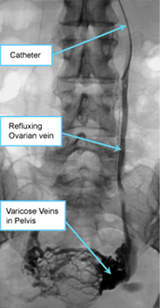Ovarian Vein Embolisation Fact Sheet
What is Ovarian Vein Embolisation?
Ovarian Vein Embolisation/ Pelvic Congestion is an examination of the blood vessels using x-rays and contrast (x-ray dye). A specialist known as an Interventional Radiologist often performs these procedures.
The contrast is injected through a thin plastic tube called a catheter, which is passed through a sheath inserted into the femoral vein.
Download PDFTo learn more about ovarian vein embolisation for pelvic congestion syndrome, read our procedures page here.
Why do I need this procedure?
Ovarian vein embolisation is a minimally invasive treatment for pelvic congestion syndrome that is used to stop blood flow through incompetent veins so they can no longer enlarge with blood, thus relieving the pain.

Diagram of Ovarian Vein Embolisation
Pelvic congestion syndrome, also known as ovarian vein reflux, is a painful condition resulting from the presence of varicose veins in the pelvis. The condition is caused by valves in the veins that help return blood to the heart against gravity becoming weakened and not closing properly, allowing blood to flow backwards and pool in the vein causing pressure and bulging veins.
The chronic pain that is associated with this disease is usually dull and aching. The pain is usually felt in the pelvis and lower back. The pain often increases during the following times:
- Following intercourse
- Menstrual periods
- When tired or when standing (worse at end of day)
- Pregnancy
Other symptoms include:
- Irritable bladder
- Abnormal menstrual bleeding
- Vaginal discharge
- Varicose veins on vulva, buttocks or thigh.
What should I expect?
- The procedure can take between 20 – 60mins.
- The contrast can cause a warm flushing or burning sensation. It only last for a few seconds and stops once the contrast has stopped being injected. Please ring MIVIR if you have a known allergy to Iodine or contrast.
- You may be required to take some time off work – please let the nurses know so they can organise a medical certificate for you. An attendance certificate can be provided for your carer on the day of the procedure.
- Please make sure you have someone to pick you up after your procedure. You procedure will be cancelled if you don’t have an escort. Please contact MIVIR as soon as possible if this cannot be arranged.
- After the procedure you may experience mild-moderate pelvic discomfort which should resolve over the following few days with original symptoms resolving over the next few weeks. You should only require oral pain medication to help relieve symptoms.
On the day of your Procedure
You will need to present to the Day Procedure Unit on the day of your procedure – your admission time will be sent to you with your appointment time. This will allow the nurses time to complete your admission paperwork and any other tests that may be required such as blood tests or pre-medication.
You will be required to fast for 4 hours before you procedure – this means no food or fluids. You may take any regular medication with a small sip of water. Please continue to take your blood pressure medication. Please bring a list of your medications with you.
Please contact MIVIR if you are taking medication for the following;
- Diabetes,
- Stroke,
- Heart Conditions such as a Heart Attack or Atrial Fibrillation.
Useful Links
Ovarian Vein Embolization – Radiology Info
Author: Dr John Vrazas
